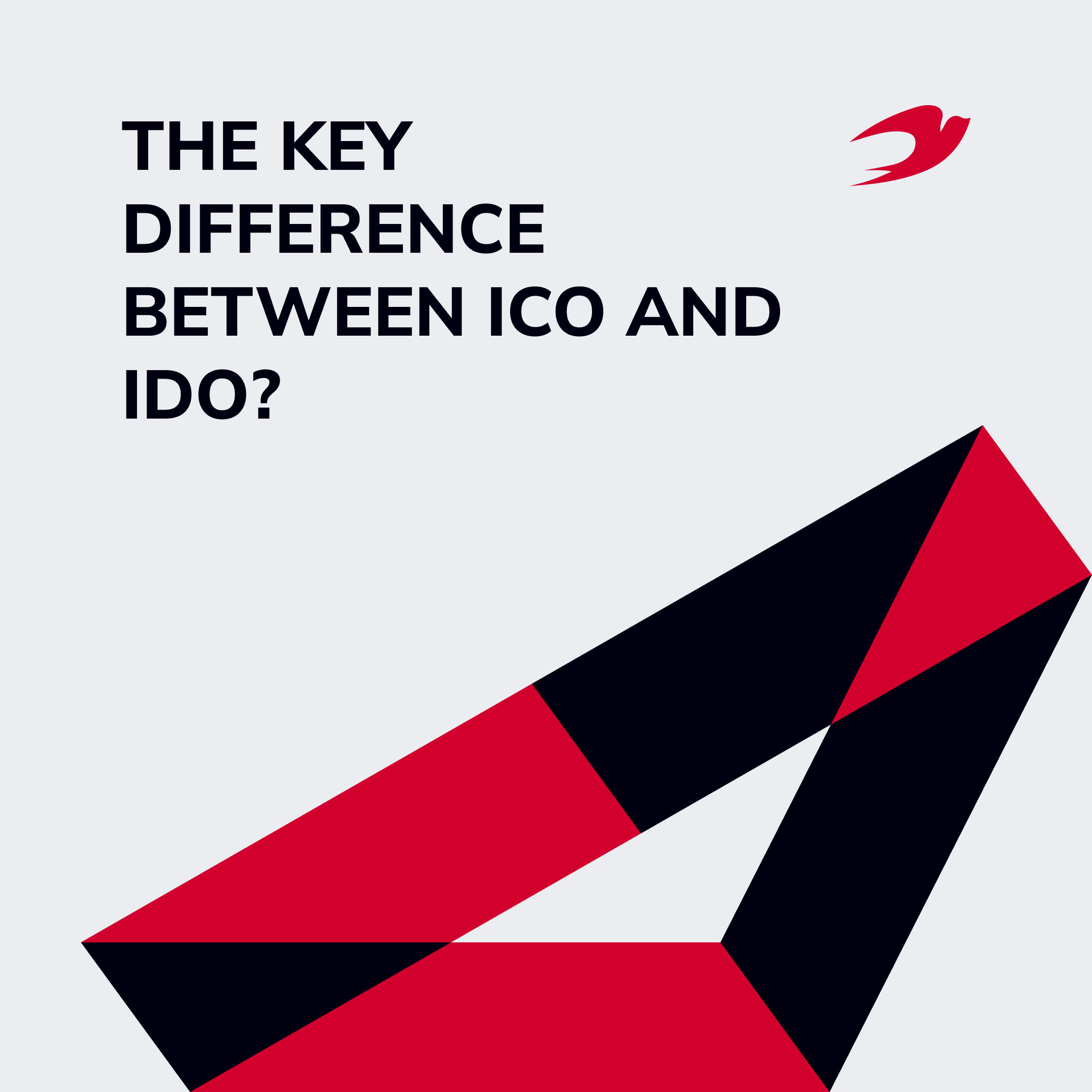Sufficient funding is one of the main factors of any startup’s success, and fundraising has always been one of the main ways to attract investments. In the world of crypto projects, this process has unexpectedly been transformed. Crypto startups have learned how to get money by pre-selling tokens. That’s how the world learned about crypto funding options like ICOs and later IDOs. In this article, we will talk about the main difference between ICO and IDO and the advantages of each crypto funding model.
Table of contents:
What is ICO?
Initial coin offerings (ICOs) used to be the most popular fundraising method in the industry. A crypto start-up seeking funding need only submit a white paper describing how the proposed system would work. Then there would be a token sale in which the coins would become the future functional units of currency. Investors who believe in the project’s potential can purchase a token for fiat funds or cryptocurrencies. This is a bet, as they hope the value of the token will rise when the project comes to market.
The ICO was first launched back in 2013. Then ICO was a fast and cheap way to attract investment and it lacked regulation. Nevertheless, it wasn’t until 2017 that the method became widespread. According to industry reports, ICOs managed to raise a staggering $5.6 billion. The fundraising method peaked around the same time that Bitcoin reached its peak at the time. You can find the biggest ICOs of 2017-2018 below:
- EOS – $4.19 billion.
- Telegram Open Network – $1.7 billion.
- TaTaTu – $575 million.
- Dragon Coin – $407 million.
- Hyundai DAC – $258 million.
- Filecoin – $257 million.
- Tezos – $232 million.
- Sirin Labs – $157.8 million.
- Bancor Network – $153 million.
- Polkadot – $145 million.
But while ICOs took several years to gain popularity, the method quickly lost its appeal to the public. In 2018, the numbers were still staggering: 1,253 conducted ICOs received a combined $8 billion from investors. However, the second half of the year saw a significant decline. In 2019, many ICOs struggled to attract investors. According to reporting documents, only 84 projects managed to raise about $350 million, much less than previous funding figures.
The decline in the popularity of ICOs occurred largely due to the influence of attackers who decided to take advantage of the systems. The industry has been plagued by speculation and greed. For example, in 2018, about half of all initial coin offerings were fraudulent, and although certain requirements and rules for ICOs have been introduced, the fundraising method has not been able to recover from the blow it received.
What is IDO
Initial DEX Offering (IDO) is one of the most effective mechanisms for raising investor funds for which the exchange platform is used. The first time such a funding model was implemented was on June 17, 2019. Within one day, 3% of the total number of issued Raven Protocol tokens were sold on the Binance DEX exchange. The price of the altcoin remained unchanged at 0.00005 BNB during the token sale.
Thanks to the high prestige of Binance, the global cryptocurrency community paid attention to the new algorithm for obtaining financial assets from investors. Many projects decided to raise funds for product development through the initial decentralized offering. According to CoinMarletCap, as of June 2021, this type of token sale accounted for 60% of the total number of options.
Here are the main advantages of IDO:
- Quick listing. Token holders usually don’t have to wait long for the coins to start trading on the exchange. The listing happens as soon as the crypto’s IDO ends.
- Availability. A simplified vetting process has allowed many more startups to raise the money they need.
- Transparency. This point is not unique in the cryptocurrency environment, but it is still convenient to be able to check token contracts and adjust your plans.
Formally, any DEX user can conduct an IDO. You just need to activate a special contract, register a new token and provide the pool with liquidity. To avoid poor IDOs, platforms select projects. Selected projects end up on launchpad platforms where crypto startups can raise capital. At Polkastarter, for example, the application process is overseen by the Polkastarter team and the Polkastarter supervisory board, which includes members of Huobi, Polygon, Alchemy, and other investors and entrepreneurs.
Most IDOs run on Uniswap, and therefore on Ethereum. But at the same time the use of other blockchains, including Solana, Polkadot, and Binance Smart Chain (BSC), is growing. Launching projects on them can help reduce network fees significantly while in some cases Ethereum’s can be too high. Therefore, more and more projects are conducting IDO on several platforms simultaneously.
The first IDO took place in June 2019, when the Raven protocol held a token sale through Binance DEX, raising over $500,000 and selling 3% of the total coins. In April 2020, the IDO of the decentralized financial contract platform UMA Protocol took place. With initial estimates of $535,000, the project is now capitalized at over $1.28 billion.
Other major IDOs include Compound, bZx Protocol, mStable, SushiSwap, Shift, ExeedMe. It is difficult to name the exact amount of money raised because the assets were instantly resold and grew in value. The coins of these projects grew tenfold after the token sale. So, how IDO is different from ICO?
Differences between ICO & IDO
IDOs have several vital advantages over ICOs, beyond the principle of decentralization. So here are three major advantages of IDO:
- Marketing efforts are shared by the platform and project rather than generated by an individual project.
- IDOs are more stable because investors don’t get all the tokens at once. This is because of the reduced size of the sale.
- Placement of tokens on DEX occurs immediately after the sale.
IDO provides fast trading, uninterrupted liquidity, and most importantly lower listing costs with no restrictions for users. IDOs are both open and more transparent and are a better way to launch a new crypto project than the ICO models used previously.
| Characteristics | ICO | IDO |
| Fundraising | Crowdfunding by issuing utility token/coin through blockchain platforms. | Crowdfunding by issuing and selling via DEX. |
| Marketing&Advertising | Project teams take care of all the advertising and marketing. | The team behind the project and DEX do the marketing and advertising. |
| Trading&Liquidity | The issuer is responsible for the transferring token. Immediate liquidity after launching in CEX. | Immediate liquidity and trading on any DEX. Providing an exchange with an unlimited token stack. |
| Trust | There are trust issues due to some tokens. issuers providing misleading information. | There are trust issues due to no KYC. integration and no control mechanism. |
| Security | Highly insecure as transactions happen on ICO project platforms which could lack proper security measures. | No risk of identity and information theft. Anonymous and highly secure transaction. |
| Fees | There is no fee due to no intermediaries. Exchange fee after launching in CEX. | No exchange fee. Only payment gas for the provision of smart contracts. |
| Regulation | Partially regulated (depends on the region) | Unregulated |
IDOs, unlike ICOs, have small market capitalization after a public offering. This is due to the vesting period for any private investors and the small number of tokens. On the other hand, the advantage of IDO is that the token is immediately listed on a decentralized platform where the offering occurred.

What the future holds for IDO
Liquidity pool-based platforms such as Uniswap are becoming more preferred for raising funding and distributing DeFi tokens. IDOs are gaining popularity and may become the new industry standard. Right now, DeFi projects raise funds mostly through IDOs. But that doesn’t mean that projects from other areas of the crypto sector will not use this funding model. Nevertheless, it is unlikely that IDO will completely replace ICO and IEO.
So, for DeFi projects, IDO is the #1 mechanism for attracting investment but for other crypto projects it may not provide the same benefits. However, as long as the decentralized finance market develops, IDO will also be used by crypto projects.
Final thoughts
The difference between ICO and IDO is significant. The Initial Dex Offering has emerged as a solution to the major problems of ICOs. Due to its decentralization, greater accessibility, absence of fees, and additional commissions, the new tokenization model could become a standard in the cryptocurrency market. But this is possible if IDO manages to solve several important problems related to ensuring equal access to the token sale for whales and small investors and protecting against Pump and Dump type schemes.
The IdeaSoft team has vast experience in crypto projects and IDO development. Our blockchain expertise has been acquired through the successful implementation of over 250 projects. Feel free to visit our blockchain services page if you need help with crypto project development. We’ll be happy to become part of your project.

